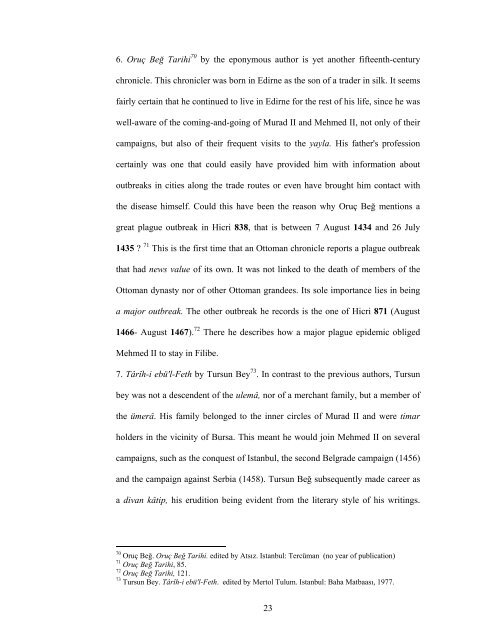the black death in early ottoman territories - Bilkent University
the black death in early ottoman territories - Bilkent University
the black death in early ottoman territories - Bilkent University
You also want an ePaper? Increase the reach of your titles
YUMPU automatically turns print PDFs into web optimized ePapers that Google loves.
6. Oruç Beğ Tarihi 70 by <strong>the</strong> eponymous author is yet ano<strong>the</strong>r fifteenth-century<br />
chronicle. This chronicler was born <strong>in</strong> Edirne as <strong>the</strong> son of a trader <strong>in</strong> silk. It seems<br />
fairly certa<strong>in</strong> that he cont<strong>in</strong>ued to live <strong>in</strong> Edirne for <strong>the</strong> rest of his life, s<strong>in</strong>ce he was<br />
well-aware of <strong>the</strong> com<strong>in</strong>g-and-go<strong>in</strong>g of Murad II and Mehmed II, not only of <strong>the</strong>ir<br />
campaigns, but also of <strong>the</strong>ir frequent visits to <strong>the</strong> yayla. His fa<strong>the</strong>r's profession<br />
certa<strong>in</strong>ly was one that could easily have provided him with <strong>in</strong>formation about<br />
outbreaks <strong>in</strong> cities along <strong>the</strong> trade routes or even have brought him contact with<br />
<strong>the</strong> disease himself. Could this have been <strong>the</strong> reason why Oruç Beğ mentions a<br />
great plague outbreak <strong>in</strong> Hicri 838, that is between 7 August 1434 and 26 July<br />
1435 ? 71 This is <strong>the</strong> first time that an Ottoman chronicle reports a plague outbreak<br />
that had news value of its own. It was not l<strong>in</strong>ked to <strong>the</strong> <strong>death</strong> of members of <strong>the</strong><br />
Ottoman dynasty nor of o<strong>the</strong>r Ottoman grandees. Its sole importance lies <strong>in</strong> be<strong>in</strong>g<br />
a major outbreak. The o<strong>the</strong>r outbreak he records is <strong>the</strong> one of Hicri 871 (August<br />
1466- August 1467). 72 There he describes how a major plague epidemic obliged<br />
Mehmed II to stay <strong>in</strong> Filibe.<br />
7. Târîh-i ebü'l-Feth by Tursun Bey 73 . In contrast to <strong>the</strong> previous authors, Tursun<br />
bey was not a descendent of <strong>the</strong> ulemâ, nor of a merchant family, but a member of<br />
<strong>the</strong> ümerâ. His family belonged to <strong>the</strong> <strong>in</strong>ner circles of Murad II and were timar<br />
holders <strong>in</strong> <strong>the</strong> vic<strong>in</strong>ity of Bursa. This meant he would jo<strong>in</strong> Mehmed II on several<br />
campaigns, such as <strong>the</strong> conquest of Istanbul, <strong>the</strong> second Belgrade campaign (1456)<br />
and <strong>the</strong> campaign aga<strong>in</strong>st Serbia (1458). Tursun Beğ subsequently made career as<br />
a divan kâtip, his erudition be<strong>in</strong>g evident from <strong>the</strong> literary style of his writ<strong>in</strong>gs.<br />
70<br />
Oruç Beğ. Oruç Beğ Tarihi. edited by Atsız. Istanbul: Tercüman (no year of publication)<br />
71<br />
Oruç Beğ Tarihi, 85.<br />
72<br />
Oruç Beğ Tarihi, 121.<br />
73<br />
Tursun Bey. Târîh-i ebü'l-Feth. edited by Mertol Tulum. Istanbul: Baha Matbaası, 1977.<br />
23
















